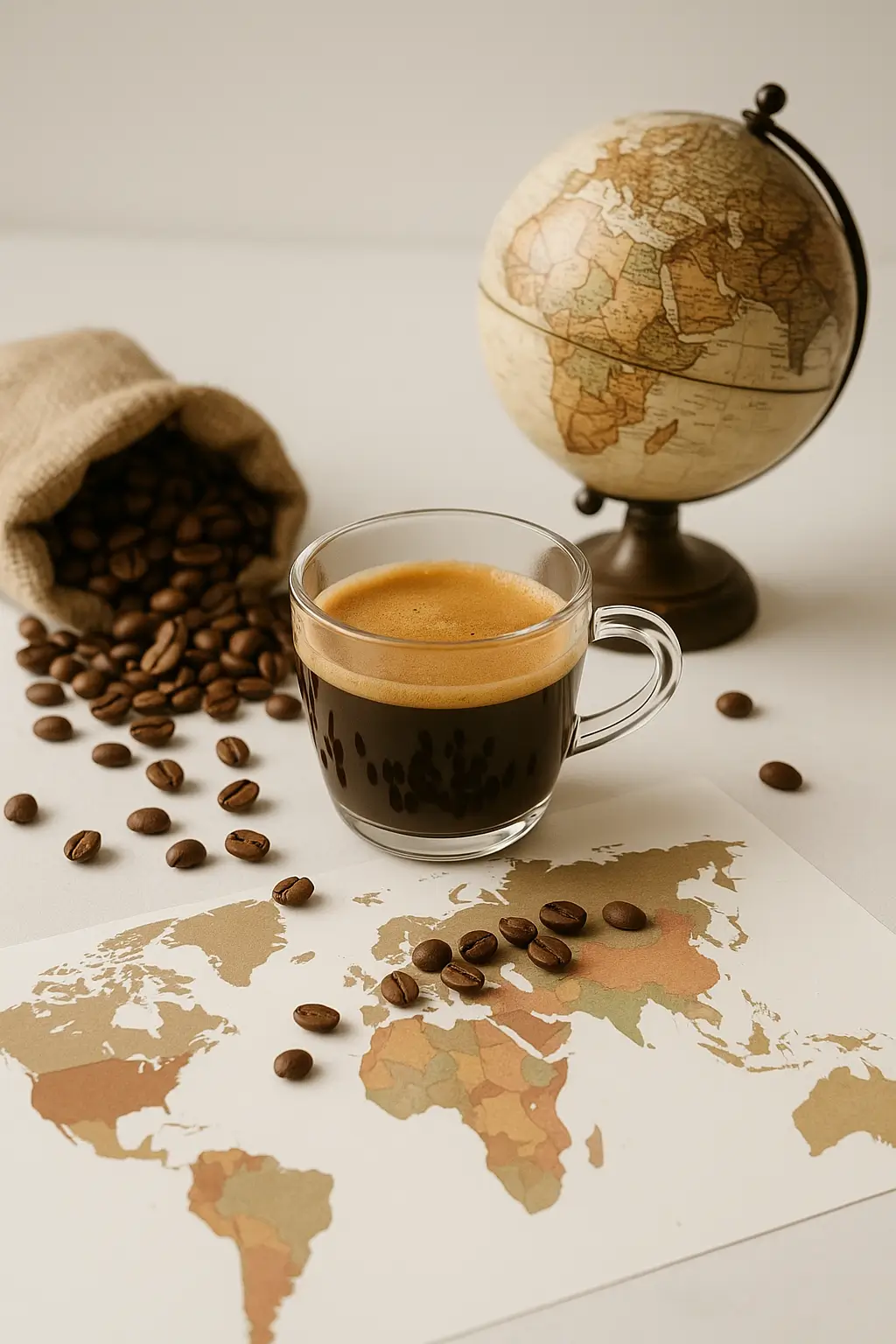Coffee is more than a morning drink. It offers a complex sensory experience. It’s rich in aroma, flavor, and nuance. Want to truly appreciate its depth? Learn how to evaluate coffee quality. This guide shows you precise methods. It moves beyond personal taste. You’ll learn about professional specialty coffee evaluation. Explore standardized systems. See what makes an exceptional cup.
- What is Specialty Coffee?
- What are the 9 Key Attributes of Coffee Quality (SCA Cupping Criteria)?
- How do Processing Methods Shape Coffee Quality?
- How do Geographical Factors and Their Impact on Coffee Flavor Profiles influence coffee quality?
- Which are the Top Coffee-Producing Countries & Their Signature Profiles, impacting coffee quality?
What is Specialty Coffee?
Specialty coffee means excellence. These beans score 80 points or higher on a standard scale. This shows superior quality. It covers everything from growing to brewing. You get a premium product. The industry gets a high standard for production and trade.
How does the SCA 100-point cupping system work?
The SCA 100-point cupping and grading system evaluates coffee. It’s the core of objective assessment. The Specialty Coffee Association (SCA) created this rigorous system. It standardizes quality worldwide. This ensures consistent scores across different tasters. Cupping is a systematic sensory analysis. It assesses many brewed coffee attributes. Professionals use it. They find the best qualities. The coffee gets a score out of 100.
Who are Q Graders in coffee evaluation?
Q Graders are certified professionals. They train rigorously. They use the SCA 100-point cupping system to evaluate coffee. They train extensively. They pass challenging exams for certification. Their expertise maintains quality. This spans from farm to roaster. They have refined palates. They understand coffee characteristics. This ensures consistent assessments.
What are the 9 Key Attributes of Coffee Quality (SCA Cupping Criteria)?
Q Graders assess coffee across nine specific attributes. Each attribute contributes to the overall score. This approach gives a full evaluation. These criteria provide a universal language for judging a bean’s value. You can think of them as:
- Fragrance and Aroma: the dry and wet smells of coffee,
- Flavor: the overall taste experience,
- Aftertaste: the lingering taste after swallowing,
- Acidity: the positive, lively quality,
- Body: how the coffee feels on your tongue,
- Balance: how all attributes work together harmoniously,
- Uniformity: consistent flavor across multiple cups,
- Clean Cup: absence of defects or off-flavors,
- Sweetness: the presence of natural sugars,
- Overall Impression: the holistic assessment of the coffee’s character.
How do aroma and fragrance influence coffee quality?
Fragrance is the dry scent. Aroma is the wet scent. Both intensity and quality matter. They are key before brewing. Evaluators score them from 6 to 10. Strong, pleasant scents promise a good cup. They set the first impression.
How does flavor define coffee quality?
Flavor describes the overall taste. It’s the heart of sensory appeal. It includes basic tastes: sweet, sour, bitter. Also complex notes: fruity, floral, nutty, chocolatey. Professionals look for balance. No single flavor should dominate. Nothing should be missing. They score flavor from 6 to 10. This shows richness and pleasantness.
What is aftertaste in coffee quality evaluation?
Aftertaste is the taste that stays after you swallow. Its pleasantness, duration, and clarity contribute to the score. A good aftertaste extends enjoyment. It leaves a clean, delightful impression. Bad notes like bitterness or harshness lower the score. They show a less refined cup. Aftertaste scores from 6 to 10. This reflects its persistence and quality.
Why is acidity important when you evaluate coffee quality?
Acidity in coffee is positive and lively. It’s not unpleasant sourness. It adds brightness and structure to the flavor profile. Evaluators score acidity from 1 to 10. Arabica coffee usually has a pH of 4.85–5.10. Balanced acidity boosts complexity. Too much sourness lowers the score.
How does body impact coffee quality?
Body is how coffee feels on your tongue. Think light, medium, or full. It defines texture and mouthfeel. It adds to the drinking experience. A balanced mouthfeel coats your palate well. It scores higher. It scores from 6 to 10. Higher values mean better texture.
Why is balance crucial when you evaluate coffee quality?
Balance means all sensory attributes work together. No one feature overpowers another. Flavors, acidity, and body combine. They create a unified, pleasant experience. High scores mean perfect harmony. No attribute stands out too much or is missing. It scores from 6 to 10. This shows its overall cohesion.
What are uniformity & clean cup in coffee quality?
Uniformity means consistent flavor. Multiple cups from the same sample should taste alike. A clean cup has no defects or off-flavors. This ensures pure coffee taste. These add up to 2 points to the score. They reward careful processing. No negative impressions means high value in specialty coffee.
How does sweetness contribute to coffee quality?
Sweetness is a positive attribute. It improves the coffee flavor. It rounds out flavors. It makes the taste pleasant. It reduces harshness or astringency. Natural sweetness elevates the experience. Evaluators note this. It can add up to 2 points to the score.
What is overall impression in coffee quality assessment?
The Overall Impression is a holistic score. It shows if coffee meets expectations. It considers its origin and character. This final judgment lets the cupper see the coffee’s unique personality. It goes beyond individual attributes. It gives a full view of excellence. It scores from 6 to 10. It captures the coffee’s complete appeal.
How do Processing Methods Shape Coffee Quality?
Coffee processing methods shape flavor. They affect quality. They control how fruit and bean interact. These techniques change sweetness, body, acidity, and clarity. Learn each method. You’ll appreciate diverse outcomes in your cup. The main methods include:
- Washed Process,
- Natural Process,
- Honey Process,
- Wet-Hulled Process.
How does the washed process impact coffee quality?
The Washed Process, or wet process, removes pulp. It takes off fruit residue before drying. You de-pulp the cherries. Often, you ferment them to break down mucilage. Then you wash them with water. The coffee tastes clean and bright. It has clear acidity and clarity. This process needs more water and skill. It highlights the bean’s true characteristics. It makes for exceptional coffee quality.
How does the natural process influence coffee quality?
The Natural Process, or dry process, dries the whole coffee cherry. The bean stays inside. The fruit’s sugars and flavors infuse into the bean. This happens while drying. Naturally processed coffees gain strong fruitiness. They have enhanced sweetness and a fuller body. It creates distinct, vibrant flavors. But it can also bring more variability. You might find less clarity than with washed methods.
How does the honey process affect coffee quality?
The Honey Process is a hybrid method. It removes the outer skin. Some sticky mucilage – fruit sugars – stays on the bean during drying. How much mucilage stays impacts flavor. “White honey” leaves less. This method gives balanced sweetness. It adds complexity. The body sits between washed and natural coffees. It creates a unique profile. It improves coffee quality.
What is the wet-hulled process in coffee quality?
The Wet-Hulled Process is unique. Indonesia uses it most often. You partially dry the beans. Then you hull them while they are moist. You dry them again. This approach yields heavy body. It creates unique flavors: chocolatey, savory, nutty. It makes for the region’s signature deep, earthy coffee quality.
How do Geographical Factors and Their Impact on Coffee Flavor Profiles influence coffee quality?
Coffee’s flavor identity comes from geography. It comes from varietals grown in its region. These elements add distinct characteristics to your cup. Understand these influences. You’ll appreciate coffee quality differences from various origins.
How does altitude affect coffee quality?
Altitude affects coffee quality. High altitudes mean denser beans. Maturation slows down. This longer development brings brighter acidity. You get more complex fruity or floral notes. Lower altitudes mean faster maturation. These beans have lower acidity. Flavors are often nutty, chocolatey, or earthy. For example, high-altitude farms in Colombia yield vibrant acidity. Brazilian low-altitude coffees offer smoother, richer profiles.
How does climate impact coffee quality?
Climate factors affect ripening. Temperature, rainfall, and humidity influence coffee quality. Warm, consistent climates with enough rain promote slow ripening. This means more sweetness and pronounced fruity notes. Ideal conditions ensure full cherry development. This adds complexity and balance to your cup. A balanced climate creates a superior coffee flavor profile.
How does soil composition influence coffee quality?
Soil composition shapes coffee flavors and overall quality. Volcanic soils, found in regions famous for Costa Rican coffee and Guatemalan coffee, are mineral-rich, adding vibrant acidity and complex flavors to the cup. Soils high in organic matter often yield robust, well-rounded profiles. The nutrients present in the soil influence the bean’s chemistry, which directly impacts its taste.
How do varietals influence coffee quality?
Coffee varietals are genetic strains. They add distinct flavor nuances and influence coffee quality. Different varietals like Arabica and Robusta adapt to specific environments and soil types. El Salvador coffee, for example, is known for the Pacamara varietal, which brings unique floral and sweet complexity. Heirloom varietals in Ethiopia yield bright, fruity, floral profiles.
Which are the Top Coffee-Producing Countries & Their Signature Profiles, impacting coffee quality?
Some countries consistently produce high-quality specialty coffee. They have unique land and refined processing. These regions developed distinct profiles. Connoisseurs worldwide enjoy them. They define global coffee quality standards.
| Country | Signature Profile |
|---|---|
| Ethiopia | Vibrant acidity, fruity, floral notes. |
| Colombia | Balanced, smooth, bright acidity, fruity, floral, caramel notes. |
| Kenya | Clean, bright, hefty body, intense acidity, black-currant scent. |
| Brazil | Full-bodied, low acidity, chocolatey, nutty notes. |
| Indonesia | Earthy, full-bodied, often spicy, dark chocolate notes (wet-hulled). |
| Central America (Guatemala, Costa Rica, El Salvador, Honduras, Mexico, Panama) | Balanced, bright acidity. |
| Rwanda | High-quality Bourbon Arabica. |
| Jamaica | Blue Mountain coffee (distinct flavors, admirable quality). |
| Peru | Distinct flavors, admirable quality. |
| India | Distinct flavors, admirable quality. |
| Zimbabwe | Distinct flavors, admirable quality. |
How does Ethiopia’s coffee quality stand out?
Ethiopia is coffee’s birthplace. It produces exceptional beans. Ethiopian coffees show vibrant acidity. They have strong fruity and floral notes. Coffee enthusiasts love these. Popular regions like Sidamo, Yirgacheffe, and Harrar are famous for these profiles. They often come from unique Heirloom varietals. Ethiopia’s coffee offers a unique sensory journey.
How does Colombia’s coffee quality achieve balance?
Colombia consistently produces premium Arabica coffee. The world praises its exceptional coffee quality. Colombian coffee is balanced and smooth. It has bright acidity. Expect delightful fruity, floral, and caramel notes. Most beans grow in the high Andes. Meticulous washed processing makes them remarkably clean. Regions like Huila, Antioquia, and Nariño offer superior coffee.
What makes Kenya’s coffee quality vibrant?
Kenya produces distinct coffee. It has a clean, bright taste, a hefty body, and intense acidity. Its signature black-currant scent adds appeal. Kenyan coffee gets premium status. Meticulous wet processing largely drives this. This careful method keeps the beans vibrant. It ensures high coffee quality.
How does Brazil’s coffee quality offer full-bodied profiles?
Brazil is the largest coffee producer. It offers much Arabica and some Robusta. Brazilian coffee has a full body and low acidity. It often features chocolatey and nutty notes. These traits make Brazilian coffees ideal for espresso. They provide a rich, creamy base. This contributes to many popular drinks.
What are Indonesia’s unique contributions to coffee quality?
Indonesia grows diverse coffee. Islands like Sumatra, Java, and Sulawesi all contribute uniquely to global coffee quality. Indonesian coffees are known for earthy, full-bodied, often spicy profiles. Wet-hulled processing is distinct. Sumatra uses it often. It creates rich, dark chocolate notes. These unique characteristics set Indonesian coffees apart. They offer a deep, complex cup.
What are other notable origins for coffee quality?
Many other regions are highly regarded. Baristas and connoisseurs value their contributions to global coffee quality. Central American countries – Guatemala, Costa Rica, El Salvador, Honduras, Mexico, Panama – produce balanced coffee. They offer bright acidity. Rwanda gains recognition for high-quality Bourbon Arabica. Jamaica – famous for its Blue Mountain coffee – Peru, India, and Zimbabwe also offer superb specialty coffee varieties. Each has distinct flavors and admirable quality.
Evaluating coffee quality is a rich journey. It goes beyond simple preference. It delves into objective sensory evaluation. We explored how sensory attributes, processing methods, and geographical origin shape coffee’s profile. Understand the SCA 100-point system. Know the role of Q Graders. You’ll appreciate the science behind your daily cup. Apply this knowledge. Explore coffee personally. Uncover new favorites. Deepen your appreciation for this complex beverage.









